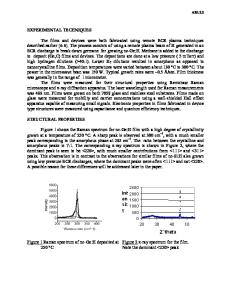Band structure and bulk modulus calculations of germanium carbide
- PDF / 248,574 Bytes
- 6 Pages / 612 x 792 pts (letter) Page_size
- 111 Downloads / 368 Views
L. Enrique Sansores Instituto de Investigaciones en Materiales, UNAM, D.F., 04510, México (Received 21 May 2004; accepted 4 November 2004)
Band-structure calculations of germanium carbide (GeC) show that it is a new indirect wide band gap semiconducting material, which crystallizes in both cubic and hexagonal phases. Through the density functional and total-energy technique in the generalized gradient approximation, the two polytypes 3C and 2H of GeC were studied. According to our calculations, it is a hard material with a percentage of covalency of about 80–90%. Important energy gaps were determined. The bulk modulus, density of states, and charge density were calculated. For the bulk modulus calculations, Murnaghan’s equation of state was used under elastic deformation to measure hardness. Our calculations showed that this semiconducting material crystallizes in zincblend (Eg ⳱ 1.76 eV) and wurtzite (Eg ⳱ 2.5 eV) structures. I. INTRODUCTION
Considerable interest has arisen in wide-bandgap materials as possible candidates for applications as blue/ ultraviolet (UV) light emitting diodes and laser diodes. Tetrahedrally coordinated wide-bandgap materials that involve the elements of the first row in the periodic table (such as Be, B, C, and N) have extreme properties compared with the other conventional semiconductors also tetrahedrally bonded. The group-III nitrides (BN, AlN, GaN) and group-IV carbide (SiC) have been extensively studied because they show, in addition to wide bandgap, high thermal conductivity and large bulk moduli, making them promising materials. In the last two decades, there have been developments in most areas concerned with these materials.1 To discover new materials with extreme properties has always been a desire for modern material scientists. Recent advances in first-principles methods and the availability of increasingly powerful computational resources make this goal increasingly achievable. Due to the excellent properties of SiC,2,3 which crystallizes into more than 200 polytypes, the authors observed that germanium carbide, GeC, the other group-IV carbide, might also present peculiar properties for optoelectronic applications due to its wide band gap.4 In spite of this interest,
there is still a lack of theoretical development in this important semiconductor.5–7 According to experimental development, germanium carbide (GexC1−x) has been prepared as an amorphous material, which has numerous attractive properties, such as high Young’s modulus, low stress, and absorption. The refractive index can be varied with composition in the range of 2–4 and graded with thickness as required. The excellent performance in these areas makes GexC1−x films applicable for design and preparation of multilayer anti-reflection and protection coatings of infrared (IR) windows.8,9 In addition, GexC1−x films may provide the apparent tunability of the band gap over a very wide range. This important characteristic can be used for photovoltaic applications, and this semiconductor has several other applications10
Data Loading...










